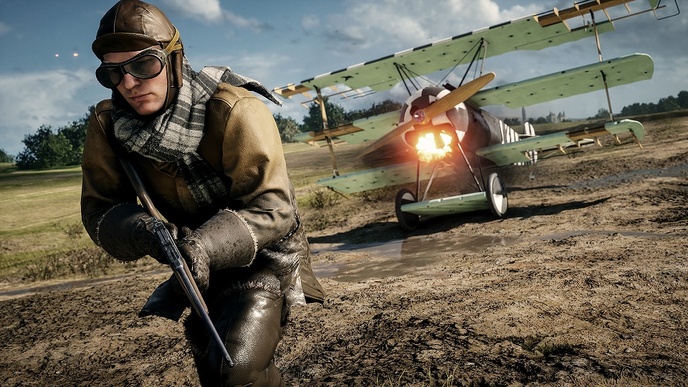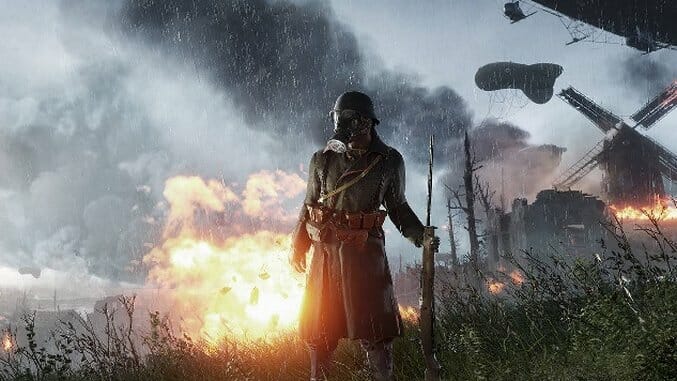“In the opinion of one observer the welcoming attitude toward war owed something to the ‘unconscious boredom of peace.’”
— Barbara W. Tuchman, The Guns of August
Battlefield 1 is a restless game. That isn’t entirely surprising given how war shooters usually play out. These are action games before they’re anything else—excuses to pump adrenaline into historical scenarios. War shooters, typically, are more concerned with shooting and explosions than making a real effort to communicate why past events are still remembered today.
At first it seems like developer EA DICE found a way to balance the demands of an action game’s relentless pace with an ambitious reinvention of genre conventions. Battlefield 1’s introductory mission, easily the most impressive part of the entire game, throws players into a suicidal defense on the Western Front, the American Harlem Hellfighters regiment desperately holding their position against a German offense. It begins in standard shooter mode, the soldier popping in and out of cover to put bullets through heads and hurl grenades into masses of advancing troops. But, before long, this character falls against the enemy onslaught. Instead of restarting from a few minutes before, hoping to get it right this time, the game displays the dead soldier’s name and his years of birth and death. The perspective shifts to a new Hellfighter who inevitably dies unceremoniously, too—from, say, being hit by a chunk of stone shrapnel or breathing in a lungful of unexpected mustard gas. The battle goes on, but the player controls a new soldier, then another and another as the grinder of the Great War turns on and on. Eventually, the sequence ends with one exhausted American standing alone amidst the rubble and gore of the battlefield. He faces a similarly battered German. Both men look each other in the eye for a few moments then lower their guns.
It’s hard to overstate how disappointing it is to see the daring of this prologue mission immediately compromised by nearly everything that follows. EA DICE has found a framework in which to merge humane and historically important context with conservative, familiar shooter design, but discards it so quickly that its previous success retrospectively comes across like a fluke.
As if happy to get a somber message out of the way, Battlefield 1 returns to the more familiar framework of individual soldiers doing extraordinarily heroic things throughout the rest of the single-player mode—a set of five more short stories from various theaters of the World War I. There’s a grizzled Australian fighting in the Battle of Gallipoli; an English tank squadron navigating the Battle of Cambrai; an Italian shock trooper pushing the Austro-Hungarians from Northern Italy near the end of the war; an American pilot inadvertently forced into aerial combat in 1917; and a Bedouin woman launching raids against the Ottoman Empire in 1918 as part of the Arab Revolt.
Each of these stories is brief, their few hours sacrificing real historic context in favor of the most exciting action sequences the developer can think up. A chapter will start, in one instance, with a few lines of dialogue explaining that Bedouin rebels are fighting to overthrow the Ottoman Empire with assistance from the British. By the time it ends the player has learned almost nothing about why the Middle East was so highly contested during the war (beyond its wealth of oil), who the Ottomans really were or the sociopolitical motivations that inspired the Arab Revolt.
In large part, the direction and acting are stellar—good enough to sell uneven writing that moves from naturalistic speech to clunkers like the prologue’s on-the-nose voiceover (“Instead of adventure, we found fear. And in war, the only true equalizer . . . is death.”) But, even instances of great presentation aren’t enough to overcome the lack of integration between the cinematic sequences’ storytelling and the nearly context-free design of playing missions that, with their emphasis on standard lone soldier heroics, feel as if they could take place during wars from most any point in the last century.
This is Battlefield 1’s largest problem. Despite its prologue’s willingness to defy the convention of immortal, ever-respawning shooter characters to make a point about the First World War’s collective hopelessness and excessive casualties, the following stories uniformly glorify the individual. In each, strong stoic soldiers take suicidal actions to protect their comrades or turn the tides of battle with lone heroism. The characters may protest otherwise in cutscenes—the Australian runner from the Gallipoli chapter is a jaded living legend who tells an enthusiastic young volunteer that he should’ve just stayed home—but the game takes constant about faces, promoting the idea that combat is not inherently heroic with one breath while showing how martial virtue is what wins wars (and earns special places in history) with the next. If carefully considered this contradiction could be a thematic statement, but Battlefield 1 never figures out what it wants to say. It seems confused as to whether it’s trying to valorize or damn the concept of combat heroism entirely.
The audiovisual design does far more of the heavy lifting, the choice of how to portray the First World War carrying a greater message than the story itself manages. Battlefield 1 is fond of placing its action during sunup and sundown, letting the optimism of the coming day juxtapose washes of mournful twilight. There are endless ruddy sands surrounding ancient ruins in maps drawn from the Sinai and Palestine Campaign. There are trampled fields and muddy brown ridges glistening in the weak light of an overcast day in maps set in late-war France. The incessant booms of nearby artillery, the bangs issuing from tanks and field guns, the crack of incoming and outgoing rifle fire, and the rallying cries of soldiers charging into battle all work to complement visuals that suggest the grand scale and the monumental import of the Great War with beautiful nuance.

The game’s fantastic look and sound, separate from the campaign’s problems, let Battlefield 1’s multiplayer modes redeem the whole project. Most of it is similar to previous games in the series—enormous maps where dozens of players join squads to snipe, shoot and heal one another between piloting tanks, planes and boats. New additions like enormous iron trains, sky-filling zeppelins, cavalry horses, gas grenades and the claustrophobic face masks worn in their midst justify the World War I setting. In multiplayer, Battlefield’s trademark wide scale and impersonal, collectivity-emphasizing style of online combat merges with the aesthetics of a global war whose battles involved mind-numbing personnel working en masse to achieve meager goals. It makes sense to place dwindling team respawn counters and capture the flag modes in this context. While returning styles of online competition work well in Battlefield 1, the addition of “Operations” stands out. It extends multiplayer battles across a series of connected “sectors,” tasking players with defending or attacking control points of huge maps. Before and after these large-scale fights, the game fills in some of the history behind the events each round is meant to depict. Left to tell its stories free of the campaign’s constraints, Operations does a far better job of abstracting the war. Its lengthy, free-form battles—set during massive, world-changing action like Germany’s spring 1918 offensive or the Italian/Austro-Hungarian Battle of Vittorio Veneto—provide impressions of First World War conflicts that surpass the game’s attempt at direct retellings.
The return of excellent multiplayer is marred, though, by another Battlefield series tradition: substantial technical problems. The PC version played for this review froze on loading screens, locked up the computer until manually reset, crashed to the desktop a few times, ate up campaign and multiplayer saves, locked vehicle movement on occasional loads and, for good measure, loaded in the final checkpoint of the final mission of the final chapter of the game with the character automatically dying before she could be moved. Luckily, the Playstation 4 version switched to for the second half of this review worked well aside from a few relatively minor bugs. War is hell, but technology, apparently, is worse.
Glitches aside, Battlefield 1 is still something of a mess. Its competitive and single-player design make strong arguments both for and against EA DICE’s decision to set its latest shooter in World War I. The multiplayer, free of the game’s limpid, confused story, subtly evokes the horror of mass death and the grandeur of industrialized battlefields filled with people fighting for small objectives swallowed by the terrible immensity of global warfare. Its solo campaign glimpses meaning in its opening, but falls flat afterward, seemingly uninterested in following through on what it starts with the Harlem Hellfighters’ unceremonious deaths.
Battlefield 1 doesn’t care about what the First World War was—why it was fought, who the belligerents really were—outside of scant paragraphs at the end of chapters and in codex entries unlocked by finding in-game items or as multiplayer achievements. We should, I think, expect any war story to synthesize and offer interpretation of the facts that make up its setting rather than simply regurgitate them. Battlefield 1 gets the look and sound of the First World War right, but is unable to answer looming questions of why the war happened and, just as importantly, why we should care.
It is, instead, preoccupied with keeping the player busy with action. It’s restless, so concerned with the excitement of battle that it loses sight of the war itself. There’s no time for context in Battlefield 1. Its developer is afraid of settling down for even a moment, worried that players will grow bored with even a second of necessary peace. This approach works in the meat-grinder of multiplayer and the series of American corpses of its opening moments, but fails elsewhere. The result is a game pulling in all directions, aesthetically coherent, but with a muddled design ethos that allows it to come near something extraordinary without ever quite achieving it.
Battlefield 1 was developed by EA DICE and published by Electronic Arts. Our review is based on the PC and PS4 versions. It is also available for the Xbox One.
Reid McCarter is a writer and editor based in Toronto whose work has appeared at Kill Screen, VICE and Playboy>/i>. He is the co-editor of SHOOTER (a compilation of critical essays on the shooter genre), edits Bullet Points Monthly, co-hosts the Bullet Points podcast and tweets @reidmccarter.

